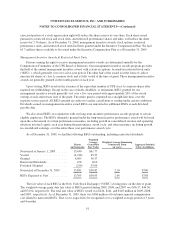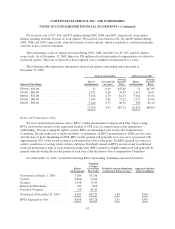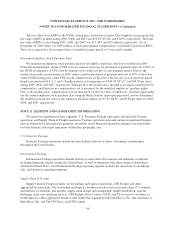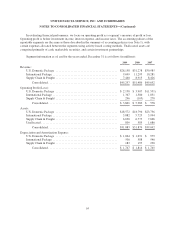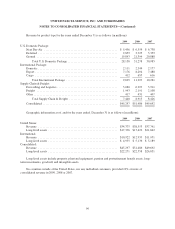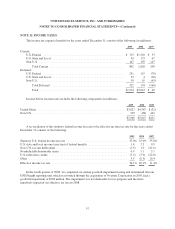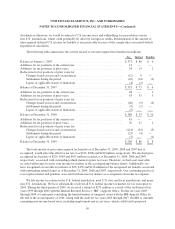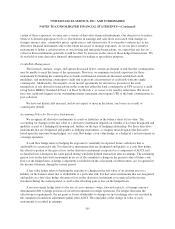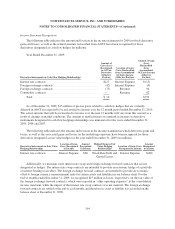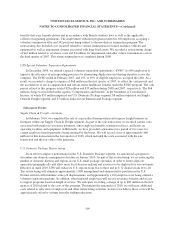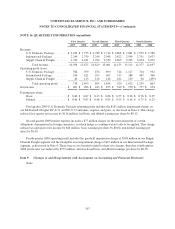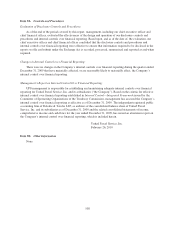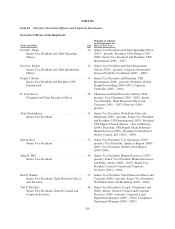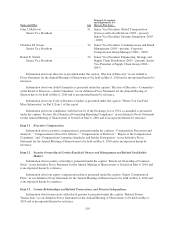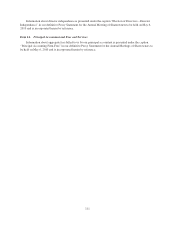UPS 2009 Annual Report Download - page 113
Download and view the complete annual report
Please find page 113 of the 2009 UPS annual report below. You can navigate through the pages in the report by either clicking on the pages listed below, or by using the keyword search tool below to find specific information within the annual report.UNITED PARCEL SERVICE, INC. AND SUBSIDIARIES
NOTES TO CONSOLIDATED FINANCIAL STATEMENTS—(Continued)
certain of these exposures, we enter into a variety of derivative financial instruments. Our objective is to reduce,
where it is deemed appropriate to do so, fluctuations in earnings and cash flows associated with changes in
foreign currency rates, commodity prices, equity prices, and interest rates. It is our policy and practice to use
derivative financial instruments only to the extent necessary to manage exposures. As we use price sensitive
instruments to hedge a certain portion of our existing and anticipated transactions, we expect that any loss in
value for those instruments generally would be offset by increases in the value of those hedged transactions. We
do not hold or issue derivative financial instruments for trading or speculative purposes.
Credit Risk Management
The forward contracts, swaps, and options discussed below contain an element of risk that the counterparties
may be unable to meet the terms of the agreements. However, we minimize such risk exposures for these
instruments by limiting the counterparties to banks and financial institutions that meet established credit
guidelines, and monitoring counterparty credit risk to prevent concentrations of credit risk with any single
counterparty. Additionally, the majority of our master agreements for derivatives provide for the early
termination of any derivative transactions in the event that either the bank counterparty or UPS receives a credit
rating below BBB by Standard & Poor’s or Baa2 by Moody’s, or ceases to be rated by either firm. We do not
have any credit-risk triggers in our outstanding master agreements that require UPS or the bank counterparties to
post collateral.
We have not historically incurred, and do not expect to incur in the future, any losses as a result of
counterparty default.
Accounting Policy for Derivative Instruments
We recognize all derivative instruments as assets or liabilities in the balance sheet at fair value. The
accounting for changes in the fair value of a derivative instrument depends on whether it has been designated and
qualifies as part of a hedging relationship and, further, on the type of hedging relationship. For those derivative
instruments that are designated and qualify as hedging instruments, a company must designate the derivative,
based upon the exposure being hedged, as a cash flow hedge, a fair value hedge, or a hedge of a net investment in
a foreign operation.
A cash flow hedge refers to hedging the exposure to variability in expected future cash flows that is
attributable to a particular risk. For derivative instruments that are designated and qualify as a cash flow hedge,
the effective portion of the gain or loss on the derivative instrument is reported as a component of AOCI, and
reclassified into earnings in the same period during which the hedged transaction affects earnings. The remaining
gain or loss on the derivative instrument in excess of the cumulative change in the present value of future cash
flows of the hedged item, or hedge components excluded from the assessment of effectiveness, are recognized in
the income statement during the current period.
A fair value hedge refers to hedging the exposure to changes in the fair value of an existing asset or a
liability on the balance sheet that is attributable to a particular risk. For derivative instruments that are designated
and qualify as a fair value hedge, the gain or loss on the derivative instrument is recognized in the income
statement during the current period, as well as the offsetting gain or loss on the hedged item.
A net investment hedge refers to the use of cross currency swaps, forward contacts, or foreign currency
denominated debt to hedge portions of our net investments in foreign operations. For hedges that meet the
effectiveness requirements, the net gains or losses attributable to changes in spot exchange rates are recorded in
the cumulative translation adjustment within other AOCI. The remainder of the change in value of such
instruments is recorded in earnings.
101


